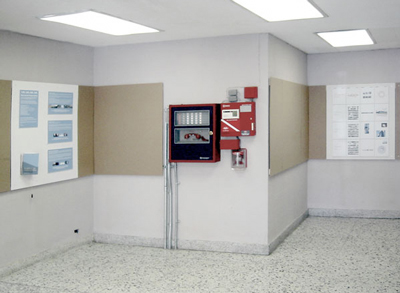Table of Contents
Common Room 2
465 Grand Street New York, Sept - Nov 2006

I have an ongoing conversation with a friend about Australia being ahead of the rest of the world in a number of ways. Australia took the lead in a new wave of neo-conservatism when it elected and kept re-electing the Howard government. The USA followed suit, Italy got themselves Berlusconi and Britain moved the whole centre-left to the centre-right.
Given the conservative cultural condition that has ensued, the ‘alternative’ art scene, particularly in Melbourne, has never been without a good idea. One of these was Melbourne’s MIR 11, a space in the foyer of the offices of architects ARM, on the 11 floor of a public car park. Now closed possibly due to differences of opinion between the directors of MIR 11 and the architects, more specifically ARM removing artworks they didn’t like from MIR 11 exhibitions (read more here especially comments).
And as one artist-run space closes usually another one opens or more interestingly becomes nomadic such as Clubsproject. So it is with interest that we note the first exhibiton at Common Room 2 a space in the foyer of Common Room architectural offices in Manhattan's lower east side. A project that will be continually renovated in an open-ended process of participatory decision making. go to review
Jacqueline Riva
465 Grand Street New York, Sept - Nov 2006

I have an ongoing conversation with a friend about Australia being ahead of the rest of the world in a number of ways. Australia took the lead in a new wave of neo-conservatism when it elected and kept re-electing the Howard government. The USA followed suit, Italy got themselves Berlusconi and Britain moved the whole centre-left to the centre-right.
Given the conservative cultural condition that has ensued, the ‘alternative’ art scene, particularly in Melbourne, has never been without a good idea. One of these was Melbourne’s MIR 11, a space in the foyer of the offices of architects ARM, on the 11 floor of a public car park. Now closed possibly due to differences of opinion between the directors of MIR 11 and the architects, more specifically ARM removing artworks they didn’t like from MIR 11 exhibitions (read more here especially comments).
And as one artist-run space closes usually another one opens or more interestingly becomes nomadic such as Clubsproject. So it is with interest that we note the first exhibiton at Common Room 2 a space in the foyer of Common Room architectural offices in Manhattan's lower east side. A project that will be continually renovated in an open-ended process of participatory decision making. go to review
Jacqueline Riva

2 Comments:
I guess there is tension in the programming of every type of art space, however it is structured or whatever support it is reliant on to survive. It's just the form of constraints or pressure points that may differ, whether these are from the business hosting the space and wondering what their commercial clients will think, or the ARI being conscious of how many artists in their program can be defined as "emerging" to make sure they are eligible for project funding here in Victoria. So the more different models attempted the better. If a space in an architects office is trying to achieve certain things, presumably these will be different from the aims of an ARI or a pulic gallery.
I'm from basekamp, one of the groups represented in the table of contents exhibition. actually, the project we contributed was a collaboration also between c.cred, and a number of other groups linking related and repeated events in 12 cities. I was also at the common room opening, so want to write a few words.
My impression is the table of contents show was meant in part to be a menu of things to come for common room. I felt we were in good company - surrounded by thoughtful, compelling work. It would be great to see more of this work by others.
Common room 1 is an architectural office, and common room 2 is the lobby of the building where their office is located (common green is the patch of greenery outside and on the sidewalk in front of the building). It's a conceptual project that's being developed in an available and accessible space.
From the descriptions of ARI, it seems the major differences between common room and ARI are accessibility and intention.
Common room, though a nicely designed office, is not exactly an elite space boosting their business with creative capital. All of the offices in their building are non-profits. Common room itself is run by ids/r and the institute for advanced architecture (socially motivated groups). Though they also engage large scale projects and high-profile clientele, my wild guess is common room won't be removing invited artists works to impress their clients.
Common Room is self-described as "a space of collaboration for cultural production with a focus on the built
environment, providing a place for shared dialogue and practice.
communication and cooperation are the basis for our design process and create an expanding resource for discovery and action."
While free and open to the public, common room is also likely to approach a cross section of people who otherwise have limited access to encountering challenging contemporary art practices. In this respect Common room joins other spaces in New York like Cuchifritos (a gallery inside of the Essex Street food market) which draws incidental audiences of varying ethnic, class, and education backgrounds as they buy food and clothes from the market.
If Table of contents is any indicator of the work to come, you can expect more trans-disciplinary, socially motivated collaborations that mingle the collective energy from within the creative cultural fields with the built environment around us and a wider public who inhabit it. We're looking forward to their next exhibition.
Post a Comment
Note: Only a member of this blog may post a comment.
Subscribe to Post Comments [Atom]
<< Home